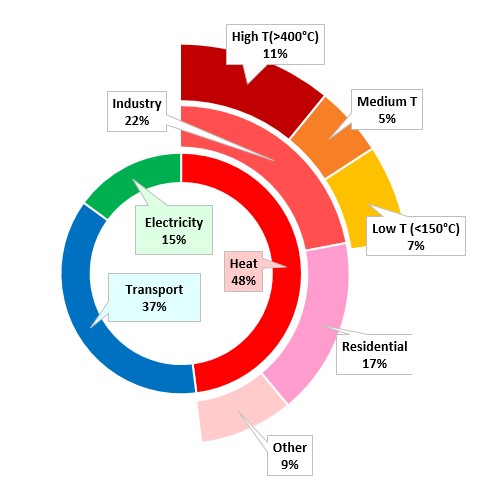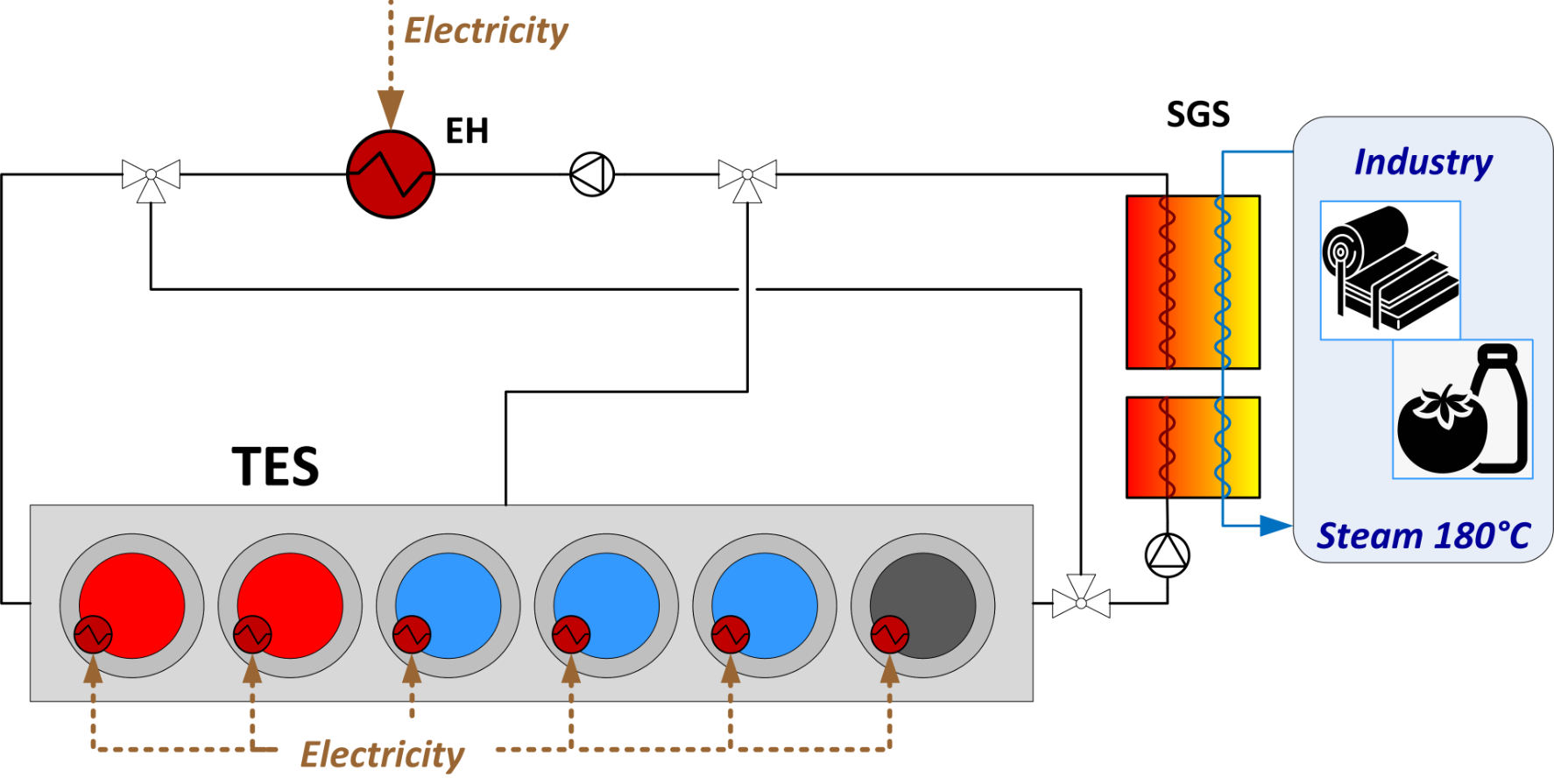RIHOND – Renewable Industrial Heat On Demand
The aim of this project is to design, assess and develop an innovative technical cost-effective solutions for integrated power-to-heat and thermal energy storage systems to satisfy the heat demand of the hard to abate industrial sector. The final goal of the project is to provide design recommendations for Kyoto Group’s next generation thermal energy storage and power-to-heat solution.
Background
The industrial sector is a major emitter of CO2 and greenhouse gases [1], and one of the main barriers and challenges in achieving the worldwide emission reduction targets [2] and sustainable development goals [3]. Today about 48 % of the overall energy demand is consumed as heat, and 22 % is spent in the industrial sector generating about 30% of the whole global carbon emissions [4]. In this context, about 16 % of the overall energy is requested as medium to high-temperature heat (at temperatures higher than 150 °C), see Figure 1.

Different industrial segments are the main responsible for such heat demand, among which are metallic industries, chemical and petrochemical, construction and cement, pulp and paper [5]. The wide majority of the heat consumed by these industries is currently produced by fossil fuels (coal 45 %, natural gas 30%, and oil 15%); only a limited 10 % is covered by renewable sources [6]. To achieve rapid decarbonization of the industrial sector, technically efficient and cost-effective solutions are deemed. Electrification of heat, commonly referred to as power-to-heat, is foreseen as a key strategy for deep decarbonization of the hard-to-abate industrial sector [7]. In order to integrate power-to-heat solutions into the industrial sector whilst ensuring reliability of the thermal supply together with reduced operational costs, thermal energy storage (TES) alternatives are fundamental [8]. The exploitation of TES units permits making use of the cheap abundant power from the grid during low demand periods as well as utilizing and stabilizing the fluctuating production from renewable sources. The load imposed to the electrical grid can be shifted, alleviating also the strain on the grid, whilst maximizing the consumption during convenient time periods (Figure 2) [9].

Specific shortcomings and potential improvements for the initial product developed by KYOTO, sketched in Figure 3, have been identified that this project will permit further enhancement.

Aim and objectives
- Identify general requirements for typical industrial users within key target markets.
- Identify and select based on techno-economic criteria a set of TES materials and fluids.
- Define the initial design of HeatCube GenX.
- Provide design recommendations for a cost-effective next generation HeatCube solution expanding KYOTO’s portfolio.
Project partners
KTH Royal Institute of Technology, KYOTO Group AS

Funding is provided by KYOTO Group AS.
Timeframe: 2022-2023
Researchers
For further information about this project, please contact Silvia Trevisan , Rafael Guedez
Publications
Trevisan S, Buchbjerg B, Guedez R. Power-To-Heat for the Industrial Sector: Techno-Economic Assessment of a Molten Salt-Based Solution. Energy Conversion and Management, 2023.
References
[1] Ritchie H, Roser M, Rosado P. CO₂ and Greenhouse Gas Emissions. Publ Online OurWorldInDataOrg 2020. https://ourworldindata.org/co2-and-other-greenhouse-gas-emissions.
[2] United Nations. Paris Agreement. 2015.
[3] United Nations. Transforming our world: the 2030 Agenda for Sustainable Development. 2015. https://doi.org/10.1163/15718093-12341375.
[4] IRENA. Global Energy Transformation: A Roadmap to 2050. Abu Dhabi: 2019.
[5] Naegler T, Simon S, Klein M, Gils HC. Quantification of the European industrial heat demand by branch and temperature level. Int J Energy Res 2015;39:2019–30. https://doi.org/10.1002/er.3436.
[6] IEA. Renewables 2021 - Analysis and forecast to 2026. Int Energy Agency Publ Int 2021.
[7] Renewable Energy Agency I. Renewable Power Generation Costs in 2017. 2018.
[8] Michaelis J, Muller T, Reiter U, Fermi F, Wyrwa A, Chen YK, et al. Comparison of the techno-economic characteristics of different flexibility options in the European energy system. Int. Conf. Eur. Energy Mark. EEM, 2017, p. 1–5. https://doi.org/10.1109/EEM.2017.7981983.
[9] IRENA International Renewable Energy Agency. Innovation Outlook: Thermal Energy Storage. Abu Dhabi: 2020.
